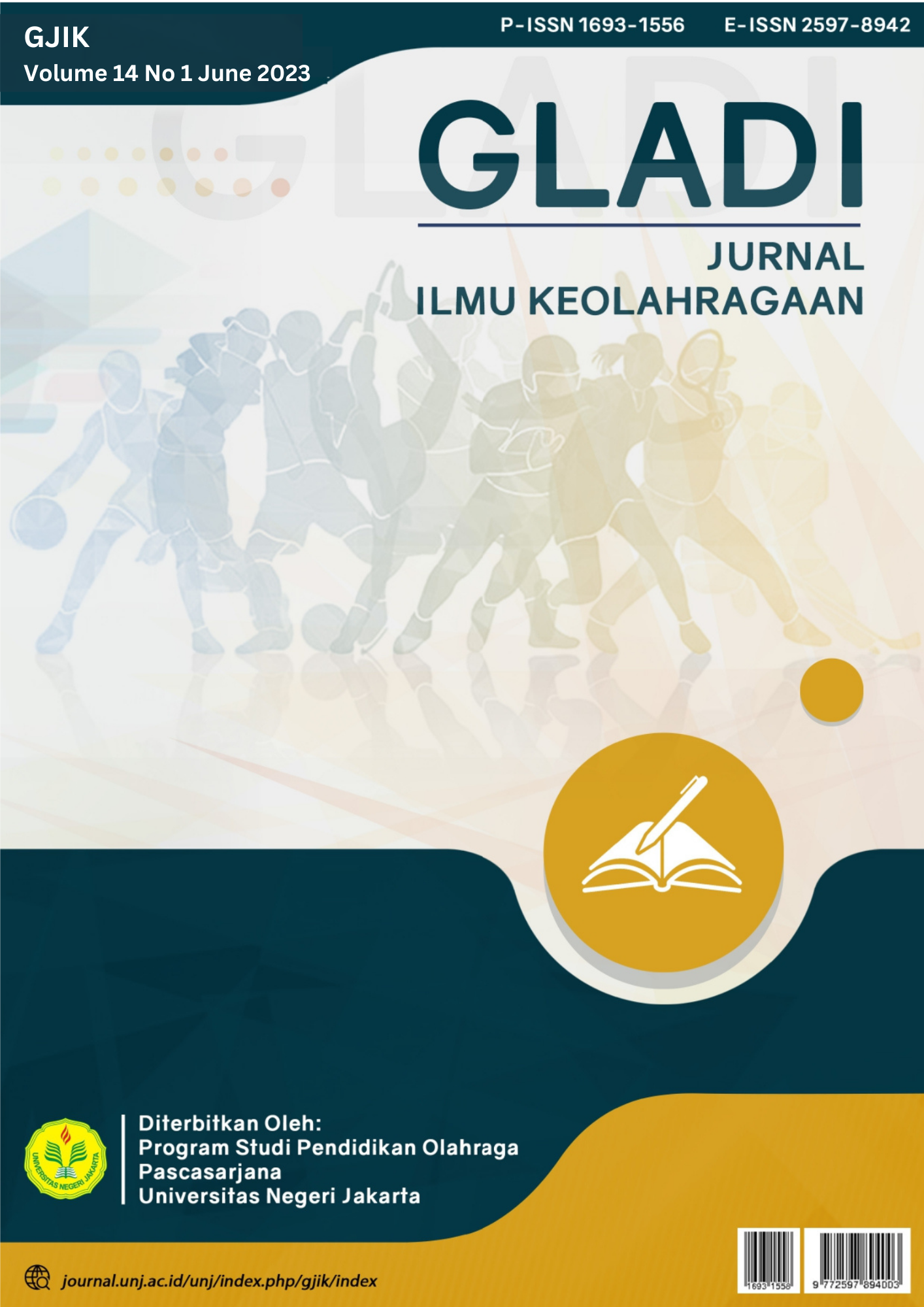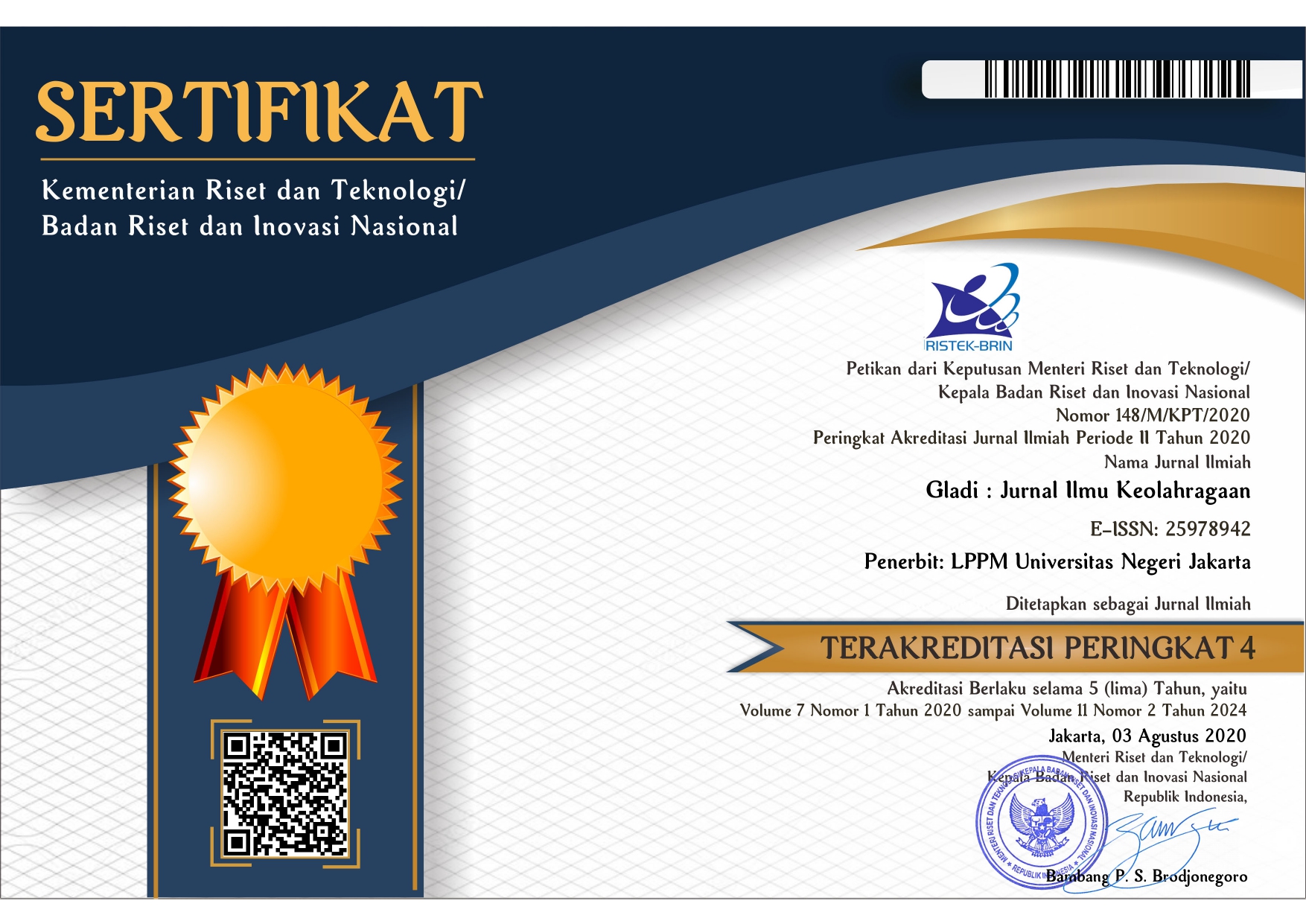Effectiveness of Motor Skills Learning Model through Sports Games for Madrasah Ibtidaiyah Students
DOI:
https://doi.org/10.21009/GJIK.142.04Keywords:
Learning model, motor skills, sports game, madrasah ibtidaiyahAbstract
Abstract This study aims to determine the motor skills learning model based on sports games as well as to test its effectiveness in improving the motor skills of elementary school (madrasah ibtidaiyah). This development research adopts the ADDIE model development and uses mixed methods, qualitative data was obtained from the description of the model, and quantitative data were obtained from field effectiveness tests. The subjects included in the development of the model were 60 underclass students 6-8 years in Kudus. Retrieval of research data using tests of motor skills learning outcomes for madrasah ibtidaiyah with validity and reliability values are categorized "good". A pre-post test was carried out for further analysis using the SPSS-23 paired sample t-test. The significance value of the difference in the t-count that appears = 16.56 df = 59 and p-value = 0.00 <0.05, there is a significant difference before and after being given the treatment of the developed model. They concluded that the model developed is in the form of 21 motor skills learning items consisting of 6 major criteria based on recorded sports games along with the procedures for implementing each item. The developed model can significantly improve motor skills learning outcomes for madrasah ibtidaiyah students.
Downloads
References
Adiyarta, K., Napitupulu, D., Rahim, R., Abdullah, D., & Setiawan, M. (2018). Analysis of e-learning implementation readiness based on integrated elr model. Journal of Physics: Conference Series, 1007, 012041. https://doi.org/10.1088/1742-6596/1007/1/012041
Agustian, N., & Salsabila, U. H. (2021). Peran Teknologi Pendidikan dalam Pembelajaran. Islamika, 3(1), 123–133. https://doi.org/10.36088/islamika.v3i1.1047
Agustina, R. , S. P. I. , & F. R. (2016). Sejarah, tantangan, dan faktor keberhasilan dalam pengembangan e-learning. SESINDO, 1(1), 210–218. https://is.its.ac.id/pubs/oajis/index.php/home/detail/1666/SEJARAH-TANTANGAN-DAN-FAKTOR-KEBERHASILAN-DALAM-PENGEMBANGAN-E-LEARNING
Farisyi, S., & Noer, S. (2021). A Meta-Analysis: Utilization of E-Learning Interactive Media In Improving The Quality of Mathematical Learning. Proceedings of the 2nd International Conference on Progressive Education, ICOPE 2020, 16-17 October 2020, Universitas Lampung, Bandar Lampung, Indonesia, 128–135. https://doi.org/10.4108/eai.16-10-2020.2305190
Alahmari, M. (2023). Exploring the Influential Factors Affecting Staff Willingness to Adopt Augmented Reality. International Journal of Information and Education Technology, 13(7), 1078–1084. https://doi.org/10.18178/ijiet.2023.13.7.1907
Albab, S. U. (2020). Analisis Kendala Pembelajaran E-Learning pada Era Disrupsi di SMK Terpadu Al-Islahiya Singosari Malang. Mudir: Jurnal Manajemen Pendidikan, 2(1), 46–57. https://dx.doi.org/10.55352/mudir.v2i1.105
Al-Ihwanah, A.-I. (2016). Implementasi E-Learning Dalam Kegiatan Pembelajaran Pgmi Iain Sulthan Thaha Saifuddin Jambi. Cakrawala: Jurnal Studi Islam, 11(1), 76–91. https://doi.org/10.31603/cakrawala.v11i1.102
Andriyatno, I., Zulfiani, Z., & Mardiati, Y. (2023). Higher Order Thinking Skills: Student Profile Using Two-Tier Multiple Choice Instrument. International Journal of STEM Education for Sustainability, 3(1), 111–124. https://doi.org/10.53889/ijses.v3i1.79
Aydin, C. H., & Tasci, D. (2005). Measuring readiness for e-learning: Reflections from an emerging country. Educational Technology and Society, 8(4), 244–257. https://www.jstor.org/stable/jeductechsoci.8.4.244
Blacer-bacolod, D. (2022). A Literature Review on Institutional E-Learning Readiness Models. 03(05), 3775–3786.
Budhianto, B. (2020). Analisis perkembangan dan faktor yang mempengaruhi keberhasilan pembelajaran daring (e-learning ). Jurnal AgriWidya, 1(1), 11–29. https://repository.pertanian.go.id/handle/123456789/10118
Budiyono Saputro, Muh Saerozi, & Fadhil Ardhiansyah. (2020). Philosophical Reflections: Critical Analysis of Learning Strategies for Science Practicum During the COVID-19 Pandemic. IJORER : International Journal of Recent Educational Research, 1(2), 78–89. https://doi.org/10.46245/ijorer.v1i2.26
Chaeruman, U. A. (2018). Mendorong Penerapan E-Learning Di Sekolah. Jurnal Teknodik, 025–031. https://doi.org/10.32550/teknodik.v12i1.417
Chang, V. (2016). Review and discussion: E-learning for academia and industry. International Journal of Information Management, 36(3), 476–485. https://doi.org/10.1016/j.ijinfomgt.2015.12.007
Cheok, M. L. , W. S. L. , A. A. F. , & M. R. (2017). Teachers’ Perceptions of E-Learning in Malaysian Secondary Schools. Malaysian Online Journal of Educational Technology, 5(2), 20–33. https://eric.ed.gov/?id=EJ1142390
D. Doculan, J. A. (2016). E-Learning Readiness Assessment Tool for Philippine Higher Education Institutions. International Journal on Integrating Technology in Education, 5(2), 33–43. https://doi.org/10.5121/ijite.2016.5203
Darab, B., & Montazer, Gh. A. (2011). An eclectic model for assessing e-learning readiness in the Iranian universities. Computers & Education, 56(3), 900–910. https://doi.org/10.1016/j.compedu.2010.11.002
Delita, F., Berutu, N., & Nofrion, N. (2022). Online Learning: The Effects of Using E-Modules on Self-Efficacy, Motivation and Learning Outcomes. Turkish Online Journal of Distance Education, 23(4), 93–107. https://doi.org/10.17718/tojde.1182760
Demir, M., & Demir, S. Sen. (2015). A comparison the factors affected on academic satisfaction of students between traditional learning and distance learning models. International Journal of Innovative Research in Education, 1(1), 01. https://doi.org/10.18844/ijire.v1i1.117
Dhani, A. R. (2021). Efektivitas E-Learning Madrasah Dalam Pembelajaran Biologi Di Man 3 Jombang. EDUTECH : Jurnal Inovasi Pendidikan Berbantuan Teknologi, 1(2), 127–133. https://doi.org/10.51878/edutech.v1i2.452
Fu, J. S. (2013). ICT in Education: A Critical Literature Review and Its Implications. International Journal of Education and Development using Information and Communication Technology (IJEDICT), 9(1), 112–115. https://www.learntechlib.org/p/111900/
Gay, L. R., Mills, G. E., & Airasian, P. (2012). Educational Research: Competencies for Analysis and Applications (10 ed.). Pearson Education.
Ghavifekr, S. , A. M. , & A. S. (2012). Management strategies for E-Learning system as the core component of systemic change: A qualitative analysis. Life Science Journal, 9(3), 2190–2196. http://www.lifesciencesite.com/lsj/life0903/316_10415life0903_2190_2196.pdf
Hashim, H., & Tasir, Z. (2014). E-Learning Readiness: A Literature Review. 2014 International Conference on Teaching and Learning in Computing and Engineering, 267–271. https://doi.org/10.1109/LaTiCE.2014.58
Hendrastomo, G. (2008). Dilema dan Tantangan Pembelajaran E-learning. Majalah Ilmiah Pembelajaran, 4(1), 1–13. http://staff.uny.ac.id/sites/default/files/132318574/Dilema dan Tantangan Pembelajaran Elearning ok.pdf
Hidayat, M. L., Prasetiyo, W. H., & Budiutami, R. (2019). Pengukuran Kesiapan Penerapan E- Learning di Kelas Bakat Istimewa Olahraga Sma Muhamamdiyah 1 Klaten. The 9th University Research Colloquium, 1(1), 1–8.
Husna, A. (2021). Kendala Yang Dihadapi Siswa dalam Pembelajaran Berbasis E- Learning di Masa Pandemi. At-Tarbiyah al-Mustamirrah : Jurnal Pendidikan Islam, 2(2), 66–73. http://dx.doi.org/10.31958/atjpi.v2i2.3718
Jayawardana, H. B. A. (2017). Paradigma Pembelajaran Biologi di Era Digital. Jurnal Bioedutika, V(1), 12–17. https://doi.org/10.26555/bioedukatika.v5i1.5628
Jayawardana, H. B. A., & Gita, R. S. D. (2020). Inovasi Pembelajaran Biologi di Era Revolusi Industri 4 . 0. Prosiding Seminar Nasional Biologi di Era Pandemi Covid-19, 6(1), 58–66. https://journal3.uin-alauddin.ac.id/index.php/psb/article/view/15544
Kurniati, N. (2022). Pembelajaran Daring dan Problematikannya. Jurnal Pendidikan dan Pembelajaran Matematika Indonesia, 11(1), 19–26. https://doi.org/https://doi.org/10.23887/jppmi.v11i1.785
Kurniawan, A. (2014). Pengukuran Tingkat Kesiapan Penerapan E-Learning Sekolah Menengah Atas Muhammadiya di Kota Yogyakarta. UNIVERSITAS NEGERI YOGYAKARTA.
Lankshear, C., & Knobel, M. (2004). A Handbook for Teacher Research: from Design to Implementation. McGraw-Hill Education.
Mailizar, M., Almanthari, A., Maulina, S., & Bruce, S. (2020). Secondary School Mathematics Teachers’ Views on E-learning Implementation Barriers during the COVID-19 Pandemic: The Case of Indonesia. Eurasia Journal of Mathematics, Science and Technology Education, 16(7), em1860. https://doi.org/10.29333/ejmste/8240
Makki, M. I. (2019). Konsep Dasar Belajar dan Pembelajaran. Duta Media Publishing.
Mosa, A. A., Naz’ri bin Mahrin, Mohd., & Ibrrahim, R. (2016). Technological Aspects of E-Learning Readiness in Higher Education: A Review of the Literature. Computer and Information Science, 9(1), 113. https://doi.org/10.5539/cis.v9n1p113
Mustofa, R. H., & Riyanti, H. (2019). Perkembangan e-learning sebagai inovasi pembelajaran di era digital [The development of e-learning as a learning innovation in the digital era]. Wahana didaktika: jurnal Ilmu Kependidikan, 17(3), 379–391. https://doi.org/10.31851/wahanadidaktika.v17i3.4343
Nisak, N. Z. (2021). Analisis Kebutuhan Bahan Ajar Biologi untuk Siswa SMA Ditinjau dari Tingkat Kesulitan Materi, Keterampilan Berpikir Tingkat Tinggi, dan Keaktifan Belajar Siswa. EduBiologia: Biological Science and Education Journal, 1(2), 128. https://doi.org/10.30998/edubiologia.v1i2.9629
Oktaviana, D., Yulleila, & Maryana. (2021). Penerapan Pembelajaran Berbasis E-Learning Dalam Mempersiapkan Generasi Milenial Di Era 4.0. 2(1), 187–193. https://doi.org/10.46838/jbic.v2i1.59
Primasari, R., Zulfiani, Z., & Herlanti, Y. (2015). Penggunaan Media Pembelajaran Di Madrasah Aliah Negeri Se-Jakarta Selatan. Edusains, 6(1), 67–72. https://doi.org/10.15408/es.v6i1.1101
Priyanto. (2008). Model E-Learning Readiness Sebagai Strategi Pengembangan E-Learning. Proceedings on The Information and Communication Technology ( ICT ) in Education, February, 267–275. http://eprints.uny.ac.id/id/eprint/28910
Qazi, M. A., Sharif, M. A., & Akhlaq, A. (2022). Barriers and facilitators to adoption of e-learning in higher education institutions of Pakistan during COVID-19: perspectives from an emerging economy. Journal of Science and Technology Policy Management. https://doi.org/10.1108/JSTPM-01-2022-0002
Rasyid, A., Gaffar, A. A., Sugandi, M. K., & Fihani, N. (2021). Pemanfaatan Media Pembelajaran Biologi Menggunakan Bioglocal di Kalangan Guru di Masa Pandemi Covid-19. Indonesian Journal of Community and Service (IJOCS), 1(2), 445–451. http://ijocs.rcipublisher.org/index.php/ijocs/article/view/106
Ritonga, N. (2017). Analisis Penggunaan Media Berbasis Teknologi Informasi Dan Komunikasi Dalam Proses Pembelajaran Biologi Di Smp Negeri Se-Kec. Medan Kota Analysis of the Usage Information Techology Base and Communication in Learning Process of Biology At Smpn All Medan Ci. Cahaya Pendidikan, 3(1), 77–87. https://doi.org/10.33373/chypend.v3i1.872
Rusli, M. (2020). Memahami E-learning: Konsep, Teknologi, dan Arah Perkembangan (L. Mayasari, Ed.; 1 ed.). CV Andi Offset.
Saekow, A. (2011). E-learning Readiness of Thailand’s UniversitiesComparing to the USA’s Cases. International Journal of e-Education, e-Business, e-Management and e-Learning. https://doi.org/10.7763/IJEEEE.2011.V1.20
Salmilah, H. (2019). Kesiapan Implementasi E-Learning ( E -Learning Readiness ). Didaktika: Jurnal Kependidikan, 8(2), 83–88. https://jurnaldidaktika.org/contents/article/view/70
Setiaji, B., & Dinata, P. A. C. (2020). Analisis kesiapan mahasiswa jurusan pendidikan fisika menggunakan e-learning dalam situasi pandemi Covid-19. Jurnal Inovasi Pendidikan IPA, 6(1), 59–70. https://doi.org/10.21831/jipi.v6i1.31562
Setiawan, H. I., Ubay, N., Haji, P., & Sulistyani, R. N. (2022). Persepsi Siswa Terhadap Penggunaan E-Learning dalam Pembelajaran Biologi di SMA Negeri 1 Godean , Sleman Students ’ Perceptions od Using E-Learning in Biology Learning at SMA Negeri 1 Godean , Sleman. 6, 43–51. https://doi.org/10.32502/dikbio.v6i1.4208
Sholihan, B. B. (2021). Efektivitas Penggunaan E-Learning Berbasis Google Clasroom Untuk Meningkatkan Motivasi Belajar Biologi (Lintas Minat) Siswa Kelas Xi Ips-1 Sma Negeri 1 Masbagik. Journal Ilmiah Rinjani : Media Informasi Ilmiah Universitas Gunung Rinjani, 9(2), 57–64. https://doi.org/10.53952/jir.v9i2.332
Soler, R., Soler, J. R., & Araya, I. (2017). Diagnosis of Educational Needs for the Implementation of Blended Courses Based on the Blended Learning Model. The Case of the Social Sciences Faculty of the National University of Costa Rica. Procedia - Social and Behavioral Sciences, 237(June 2016), 1316–1322. https://doi.org/10.1016/j.sbspro.2017.02.216
Sudarisman, S. (2015). Memahami Hakikat dan Karakteristik Pembelajaran Biologi Dalam Upaya Menjawab Tantangan Abad 21 Serta Optimalisasi Implementasi Kurikulum 2013. Journal Florea, 2(1), 29–35. https://doi.org/10.25273/florea.v2i1.403
Wahyudi. (2021). E-Readiness Pembelajaran Berbasis E-Learning Studi Lapangan di Universitas Islam Negeri Maulana Malik Ibrahim Malang [Pascasarjana UE-Readiness Pembelajaran Berbasis E-Learning Studi Lapangan di Universitas Islam Negeri Maulana Malik Ibrahim Malang]. http://etheses.uin-malang.ac.id/25679/1/18710050.pdf
Werdiningsih, W. (2021). Manajemen Sumber Daya Manusia dalam Meningkatkan Kompetensi Guru Melaksanakan Pembelajaran Daring. Southeast Asian Journal of Islamic Education Management, 2(1), 113–124. https://doi.org/10.21154/sajiem.v2i1.48
Zine, M., Harrou, F., Terbeche, M., Bellahcene, M., Dairi, A., & Sun, Y. (2023). E-Learning Readiness Assessment Using Machine Learning Methods. Sustainability, 15(11), 8924. https://doi.org/10.3390/su15118924
Zufria, I. (2016). Pemanfaatan Media Digital (E-Learning) dalam Memaksimalkan Proses Belajar Mengajar (PBM) di Perguruan Tinggi. NIZHAMIYAH, 6(1), 28. http://dx.doi.org/10.30821/niz.v6i1.23
Zulfiani. (2023). Inkuiri dan Teknologi. Konsep dan Praktik Pembelajaran Sains. Rajawali Pers.







